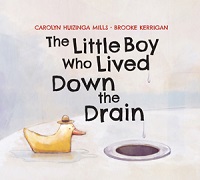| ________________
CM . . . . Volume XXIV Number 14. . . . December 8, 2017
excerpt:
There were many reasons why Sally loved taking baths, but the most exciting of all was because she got to talk to the little boy who lived down the drain. Curious young Sally had many questions for the boy: Where was the rest of his family? Was he stuck there? What was he doing with that bag of wool? Determined to talk to the little boy who lived down the drain, she first tried shouting into it. That didn’t work. So during her next bath, she tried whispering in the round metal cover beneath the tap. No response. But this time, her voice echoed, and she envisioned a teeny little boy sitting on a stool at the bottom of the drain. She imagined that his voice must be as teeny as his body and, therefore, nearly impossible to hear, and so Sally did all of the talking while the little boy listened. She talked, and talked, and explained to the little boy how everyone in her family was always too busy to listen to her. Though she greatly enjoyed sharing her thoughts with the boy down the drain, eventually there came a point where Sally wanted to hear what he had to say. In an attempt to get his response, she cupped her hands around the hole and said, “I know you’re probably trying, but you need to try something different!” Miraculously, she heard something back this time: “Try something different rent ent…” That’s it! She should try something different to get her family’s attention. From that point on, she tried new ways to get her family to listen to her, like sharing her food to stop her baby brother from crying and inviting her sisters to play with her set of chalk. It worked! Her baby brother began to smile at her, and her sisters laughed at her jokes in the fort that they all built together. She had so many people to talk to now that she stopped talking to the little boy who lived down the drain. Sally began to feel badly and wondered if he missed her. Thankfully, she soon heard her mom sing a new familiar song, but this time the little boy lived down the lane. Surely there are young children who, like Sally, can relate to the feeling of being neglected in comparison to their siblings. Sally’s vivid imagination leads her to a unique solution as she makes up the imaginary little boy who lives down the drain. Although the story title seems a bit odd, it makes sense early on as Sally’s mother sings the familiar lullaby “Baa Baa Black Sheep” to her little brother. Even children who may not be familiar with the lullaby or have a personal connection to the main character can appreciate the creativity and humour in this story. The amount of text on each page makes The Little Boy Who Lived Down the Drain an ideal read aloud for the very young end of the intended audience. Having said that, the vocabulary used throughout is simple enough that children in their beginning stages of reading could likely read some sight words or apply basic reading strategies to decode them. Carolyn Huizinga Mills is a Canadian early years teacher. The Little Boy Who Lived Down the Drain is her first picture book. The full page illustrations created by Brooke Kerrigan bring Sally’s family and imaginary world to life. Sally’s brightly coloured outfits among the overall muted colour palette suit her playful and fun personality. The exaggerated facial expressions of characters makes it quite obvious what is happening in the story, even without reading or listening to the words on each page. Highly Recommended. Andrea Boyd is an early years educator in Winnipeg, MB.
Next Review |
Table of Contents for This Issue
- December 8, 2017. |
